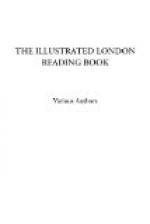[Illustration: OWLS IN A CASTLE KEEP.]
* * * * *
CHATTERTON.
[Illustration]
This gifted young poet was the son of a schoolmaster at Bristol, where he was born, in 1752. On the 24th of August, 1770, he was found dead, near a table covered with the scraps of writings he had destroyed, in a miserable room in Brook-street, Holborn. In Redcliffe churchyard, Bristol, a beautiful monument has been erected to the memory of the unfortunate poet.
O God! whose thunders shake
the sky,
Whose eye this
atom globe surveys,
To Thee, my only rock, I fly—
Thy mercy in thy
justice praise.
Oh, teach me in the trying
hour,
When anguish swells
the dewy tear,
To still my sorrows, own Thy
power,
Thy goodness love,
Thy justice fear.
Ah! why, my soul, dost thou
complain,
Why, drooping,
seek the dark recess?
Shake off the melancholy chain,
For God created
all to bless.
But, ah! my breast is human
still:
The rising sigh,
the falling tear,
My languid vitals’ feeble
rill,
The sickness of
my soul declare.
CHATTERTON.
* * * * *
SMYRNA.
[Illustration: Letter T.]
This city and sea-port of Natolia, in Asia, is situate towards the northern part of a peninsula, upon a long and winding gulf of the same name, which is capable of containing the largest navy in the world. The city is about four miles round, presenting a front of a mile long to the water; and when approached by sea, it resembles a capacious amphitheatre with the ruins of an ancient castle crowning its summit. The interior of the city, however, disappoints the expectations thus raised, for the streets are narrow, dirty, and ill-paved, and there is now scarcely a trace of those once splendid edifices which rendered Smyrna one of the finest cities in Asia Minor. The shops are arched over, and have a handsome appearance: in spite of the gloom which the houses wear, those along the shore have beautiful gardens attached to them, at the foot of which are summer-houses overhanging the sea. The city is subject to earthquakes and the plague, which latter, in 1814, carried off above 50,000 of the inhabitants.
About midnight, in July, 1841, a fire broke out at Smyrna, which, from the crowded state of the wooden houses, the want of water, and the violence of the wind, was terribly destructive. About 12,000 houses were destroyed, including two-thirds of the Turkish quarter, most of the French and the whole of the Jewish quarters, with many bazaars and several mosques, synagogues, and other public buildings. It was calculated that 20,000 persons were deprived of shelter and food, and the damage was estimated at two millions sterling.




